Main Content
Alpacas are often raised for their soft and luxurious fleece (sometimes called fiber to differentiate it from the fleece of a sheep). Each shearing produces roughly five to ten pounds of fleece per animal, per year. This fleece, often compared to cashmere, can be turned into a wide variety of products from tapestries and blankets to yarn and apparel. Alpaca fleece is recognized around the world for its fineness, softness, light-weight durability, excellent thermal qualities, and sheen. Unlike the fleece of a sheep, alpaca fleece contains no lanolin making it hypoallergenic.
Alpaca fleece has a great variety of natural colors, making it very much in vogue! There are many shades and variations of white, beige, fawn, brown, black, and grey. White, light fawn, and light grey can be easily dyed, thus offering a rainbow of colors to the fiber artist. Alpaca fleece can also be combined with other fine fibers such as merino wool, cashmere, mohair, silk, and angora to attain wool blends.
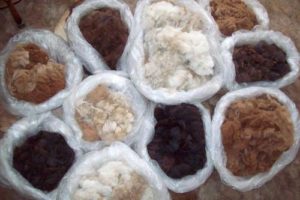
Shearing is important as alpacas do not shed their fleece. They have an exceptionally thermal fleece, and can easily overheat in summer if their fleece is not removed. Most alpacas need to be shorn once per year, usually in the late spring to early summer months. So even if you have your alpacas as pets, and have no interest in their fleece, you will still need to annually have them shorn, to keep them healthy and comfortable.
Shearing day is one of the most important days of the year for any alpaca owner. It can be a hectic and stressful time, but it doesn’t have to be. With the proper preparation, stress on the owner and the animal can be and should be minimal. John Fifield of the High Country Alpaca Ranch in New Mexico wrote in a Shearing Day Guide that “steady and methodical trumps hurried and scattered any day.”
Preparation is the key! Planning ahead reduces stress to both the animals and you. Having the necessary supplies and appropriate number of helpers is essential. Shearing is normally a 3-person job – In addition to the shearer, and the handler holding the alpaca’s head, it is useful to have a third person to remove the fleece as it comes off the alpaca.
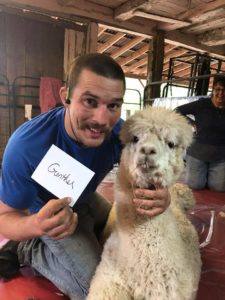
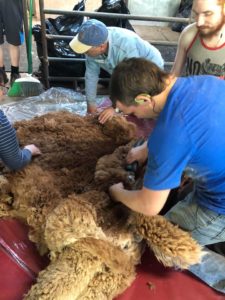
There are two main methods of shearing: while the animal is standing or lying on its side. If the ‘laying the animal on its side’ method is used, make sure to tie it in such a manner that it is unable to stand until released. The standing method is probably less stressful for the animal, but too much movement on the part of the animal creates risk of injury from the shearing blades. It is also a good idea to take advantage of the animal being restrained, and check and trim its toenails and teeth.
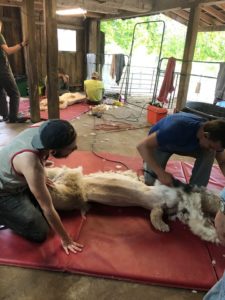
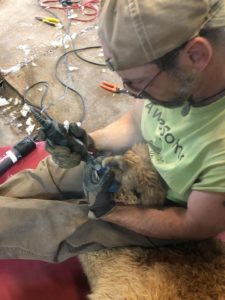
Most alpacas owners leave their forelocks (the fluffy puff of fleece that grows between, and in front of, the ears) unshorn. However, you may want to trim hair that hangs down over the eyes if it is starting to impede the alpaca’s vision. Tails can have a pompom left on the bottom, if desired, giving the alpaca a puff-ball look!
By Michelle Teitsma, 4-H Program Associate, Rutgers Cooperative Extension of Warren County
Sources:
John and Carolyn Fifield of High Country Alpaca Ranch located in New Mexico
John and Susan Merrell of Gateway Alpaca Farm located in Oregon
Photo Credit:
Natalie Burger of Hidden Pastures Farm in Branchville, New Jersey